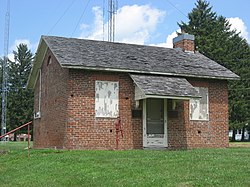The Studabaker-Scott House and Beehive School are two historic buildings near the city of Greenville in Darke County, Ohio, United States. Located along State Route 49 south of the city,[1] both are unusually well-preserved remnants of the architecture of the middle third of the 19th century.
Studabaker-Scott House and Beehive School | |
 Front of the Beehive School | |
| Nearest city | Greenville, Ohio |
|---|---|
| Coordinates | 40°4′15″N 84°37′56″W / 40.07083°N 84.63222°W |
| Area | 0 acres (0 ha) |
| Built | 1835 |
| Architectural style | Victorian, Greek Revival, Federal |
| NRHP reference No. | 78002053 [1] |
| Added to NRHP | June 15, 1978 |
A native of Pennsylvania, Abraham Studabaker settled in Scioto County, Ohio in 1795; after moving northwest to Warren County, he travelled north and built a cabin in modern-day Darke County in 1808,[2]: 253 becoming the first settler within the present boundaries of Adams Township.[2]: 417 From the county's earliest years, Studabaker was a prominent member of local society; when Darke County was formed in 1816, he was elected to the county commission.[3] Moving to Greenville Township in 1815,[2]: 238 he built a larger homestead in 1835, but it was a simple structure like that of most period houses.[3]

In the 1850s, many former pioneers began to expand their homesteads: as prosperity increased, landowners renovated their old houses according to the prevailing architectural styles of the day. Studabaker followed this pattern; his old farmhouse took on a mix of the Early Victorian and Greek Revival architectural styles, and its location along one of the county's most important roads gave his house a prominence enjoyed by few other houses in the area.[3]
Located very close to Abraham Studabaker's house is the Beehive School. Built in 1846, it was one of the earliest permanent school buildings — in contrast to the primitive log structures built by the first settlers — in Darke County.[1] Unlike the Studabaker House, this brick building features elements of the Federal style of architecture.[4]
In 1978, the house and school were listed on the National Register of Historic Places. Although the two buildings both qualified for inclusion on the Register, they and a third contributing building were listed together as a single property. Key to their being listed on the Register was their well-preserved historic architecture and their connection to Abraham Studabaker, because of his place as one of the region's leading pioneers.[1]
References
edit- ^ a b c d "National Register Information System". National Register of Historic Places. National Park Service. March 13, 2009.
- ^ a b c The History of Darke County, Ohio: Containing A History of the County; Its Cities, Towns, etc.; General and Local Statistics; Portraits of Early Settlers and Prominent Men; History of the Northwest Territory; History of Ohio; Map of Darke County; Constitution of the United States, Miscellaneous Matters, etc., etc. Chicago: Beers, 1880.
- ^ a b c Owen, Lorrie K., ed. Dictionary of Ohio Historic Places. Vol. 1. St. Clair Shores: Somerset, 1999, 308.
- ^ Studabaker-Scott House and Beehive School, Ohio Historical Society, 2007. Accessed 2010-07-29.
External links
editMedia related to Studabaker-Scott House and Beehive School at Wikimedia Commons

